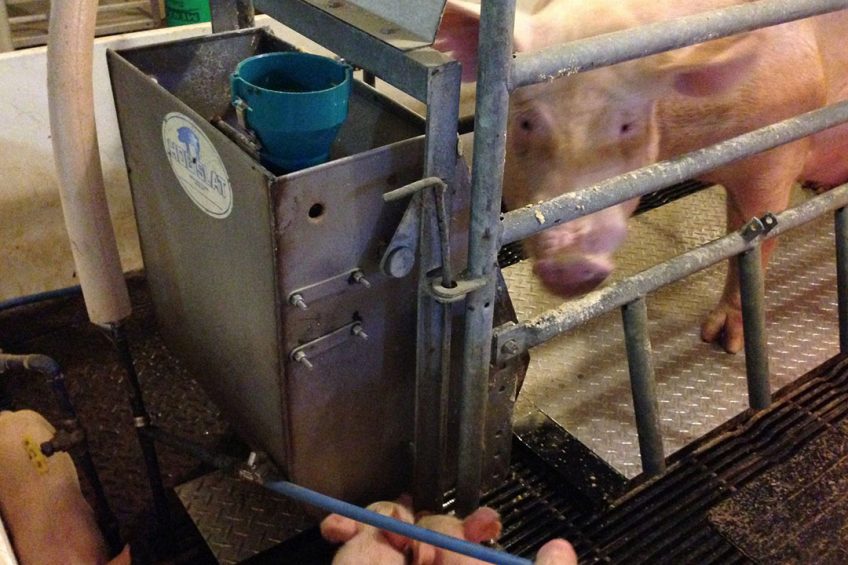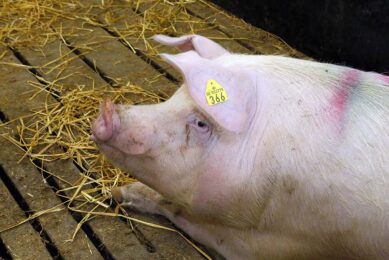Cooling pads for sows during farrowing and lactation

For sows to feel well in the farrowing and lactation house, its best that temperatures do not rise too high. Heat stress, however, does often occur, e.g. due to hot summers, high prolificacy or an indoor climate that is aimed at making newborn piglets feel comfortable. Cooling pads may help.
Heat stress has negative effects on sow productivity and reproductive performance. It has multiple impacts on animal metabolism and physiology. These include:
- Increased body core temperature;
- Increased blood flow to the skin to dissipate radiant heat;
- Increased respiration rates to remove the excess heat; and
- Reduced feed intake as a strategy to reduce heat production.
Consequently, sows under heat stress have reduced milk production and litter weight gain. Sows with excessive body protein loss during lactation have increased days from weaning to oestrus and reduced conception rates.
During the last 3 decades, continuous selection for increased litter size and milk production has increased the heat production of sows and reduced their upper critical temperature. This selection has also resulted in decreased piglet birth weights and less body energy reserves at birth, requiring greater farrowing room temperatures and the use of heat pads or heat lamps to provide local heat for piglets.
Cooling pad to remove excess heat
The Animal Sciences and Agricultural Biological Engineering Departments at Purdue University and the USDA-ARS Livestock Behavior Research Unit have been working together for the last three years to develop a cooling pad able to efficiently remove excess heat from lactating sows.
Floor cooling is based on the conduction of heat from the source (the animal) to a sink (chilled water running through the pipes), while the animal is lying down. Aluminium and copper are able to effectively transfer heat between the two temperatures. The cooling pad has been built with a heavy-duty aluminium plate in the surface, high-density polyethylene base and copper water pipes attached to the aluminium plate (see picture). From these initial tests, pad dimensions were enlarged, and the range of constant flow rates, time between flushes and desired upper set temperatures for different environmental conditions were refined.

Sow lactation trials
The refined cooling pad designs have been used in sow lactation trials, shown in the smaller picture. Sows with no cooling spent more time in a ‘dog like posture’ to increase body heat dissipation to the environment, less time on the feeder and less time milking in comparison to the sows with active cooling. After 80 min of cooling, sows with active cooling had lower respiration rates (45 vs 122 breaths/min), heart rates (100 vs 119 beats/min), vaginal temperature (39.2 vs 40.1ºC), rectal temperature (39.0 vs 40.0ºC) and skin temperature (38.6 vs 39.4ºC) than sows with no active cooling, respectively. The heat removal rate was three to four times greater than previous cooling pad designs made of concrete and steel pipes, covering entire floor sections.
The effectiveness of the sow cooling pads for an entire lactation was evaluated under mild and moderate heat stress conditions. The moderate heat stress room was targeted to achieve 32ºC from 8am until 4pm and 27ºC for the rest of the 24-hour day. The mild heat stress room was targeted to achieve 27ºC and 22ºC for the same periods, respectively.
Soon, Pig Progress together with All About Feed will publish a special edition about Heat Stress
Yorkshire-Landrace sows were blocked by parity and body weight, and assigned to two farrowing rooms which differed only in environmental temperature. Each sow was provided an eight-row cooling pad.
Figure 1 – Least-squares means for respiration rate for the mild heat stress room.

Reducing the effects of heat stress
Sows received either a constant cool water flow of 0.00 litre/min (‘Control’, nine sows), 0.25 litre/min (‘Low’, 12 sows), or 0.50 (‘High’, 10 sows) litre/min. Water inlet and outlet temperatures and flow rates were recorded to estimate heat removal. Respiration rates (RR), rectal temperatures (RT) and skin temperatures (ST) were recorded daily (at 7pm and at 3pm) from the second day in the farrowing room to weaning at a mean age of 19 days.
The sow cooling pads reduced the measures of heat stress. The low flow rate was adequate for the mild heat stress room and the ‘High’ flow rate was needed for the moderate heat stress rooms.
Figure 2 – Least-squares means for respiration rate (RR) for the moderate heat stress room.

Please contact Dr Abhijit Karve of the Purdue University Office of Technology Commercialization for licensing opportunities.
References available on request.
Co authors: Robert Stwalley, Jacob Maskal and Francisco Cabezón contributed on behalf of Purdue University, IN, United States; Jay Johnson and Jeremy Marchant-Forde are attached to USDA-ARS.
Join 18,000+ subscribers
Subscribe to our newsletter to stay updated about all the need-to-know content in the pigsector, three times a week. Beheer
Beheer













 WP Admin
WP Admin  Bewerk bericht
Bewerk bericht